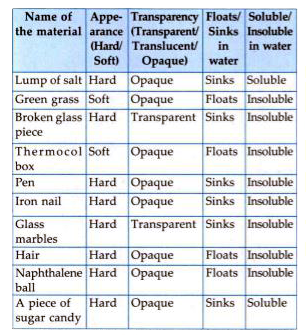During summer holidays, a group of children collected a lump of salt, green grass, broken glass piece, a small thermocol box, pen, iron nail, glass marbles, hair, naphthalene ball, a piece of sugar candy (mishri) and tried to group them on the basis of properties given in table. Help them in filling the table.

Text Solution
|
Similar Questions
Knowledge Check
Although every element is different from every other element, yet some elements have certain similarities. Based upon these similarities, the scientists after numerous attempts were are given. Based upon these multiple choice questions are ultimately sucessful in arranging the various elements into groups or chemical families in such a way that similar elements were put together. This arrangement of elements is called classification of elements and this led to the formulation of a periodic table. The periodic table is the most organising principle in chemistry. If you know the properties of any element in a group, or of the columns, of the periodic table, you can make a good guess at the properties of every other element in the same group and even the elements in the neighbouring groups. The first break through in the classification of elements, was provided by Russian chemist Dmitri lunovich Mendeleev. Taking the chemistry of the elements as his primary organising principle, he arranged the known elements by atomic mass and grouped them together according to their chemical reactivity He also observed that there occurred recurrence of elements with similar physical and chemical properties after certain regular intervals. On the basis of these similarities Mendeleev proposed his periodic law which states that physical and chemical properties of elements are a periodic function of their atomic masses Moseley suggested that atomic number was a better fundamental property of an element than its atomic mass. This forms the basis of the Modern periodic law. Thus, modern periodic law states that physical and chemical properties of the elements are a periodic function of their atomic numbers. In the modern long form of periodic table the elements are arranged in the increasing order their atomic numbers and the elements with similar properties repeat after regular intervals. Repetition of chemical properties of elements at regular intervals when arranged in a definite order is called periodicity of properties. This is due the recurrence of similar outer electronic configuration at certain regular intervals. The long form of periodic table may be divided into four main blocks known as s, p, d and f blocks depending upon the type of orbitals being filled up with the increase in atomic number in atoms of the elements. The nature of the block to which an element belongs depends upon the type of subshell which receives the last electron.
In the long form of periodic table, all the non-metals are collectively placed inAs-blockBp-blockCf-blockDd-block


